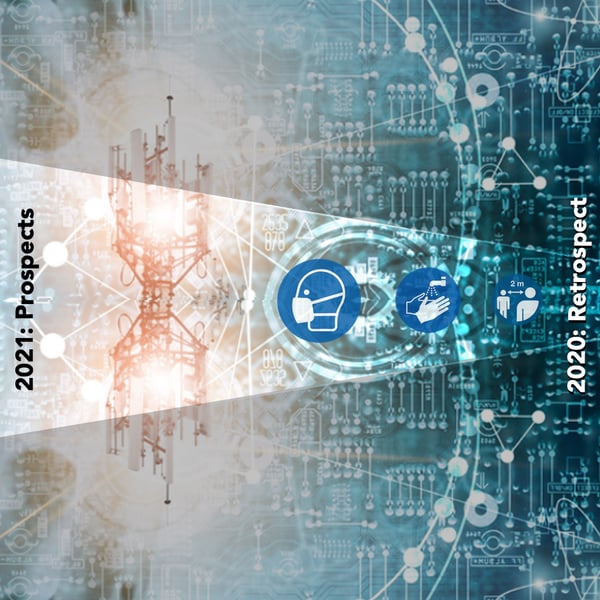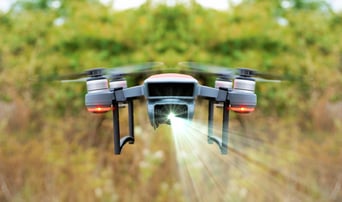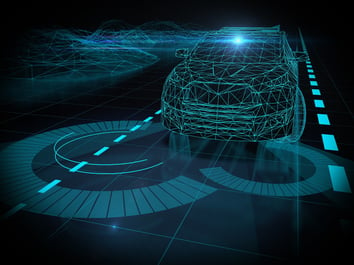As we reflect on the events of 2020 and anticipate their unfolding in 2021, our vision sharpens to reveal a clear trifecta of forces affecting the semiconductor ecosystem, rapid change, foundational stabilities, and the discernible direction we are headed. In what follows, we pay special attention to the intersection between these forces and defense, space and security, health, data and communications, and the green economy.

Within these parameters, we may note the following four-fold dynamic:
1. While aerospace languishes from the impact of the COVID-19 pandemic, the legislative push towards green aeronautical technologies presses on relentlessly; the first electric-powered airplanes are due to enter service mid-2025.
2. Global changes in work practices combined with the increased use of remote tracking and logistics processes have heightened demand for data and ensured that the rollout of 5G has become more urgent and concomitantly the increased demand placed upon Datacom.
3. Workplace people distancing in 2020 has considerably sped-up the implementation of robotics, automation, and autonomous processes. This creates yet more demand in the 5G and data/communication carriers.
4. Geo-politically, the big powers are poised to enact significant increases in planned military expenditure over the next half-decade; we especially note the focus on high-tech, naval, signals intelligence, and out-of-atmosphere defense capabilities.
This list is only the tip of the proverbial iceberg both in respect to the list of technologies that could be listed and with respect to current mega-trends. That having been said, these do represent the fundamental convergence of melding the semiconductor ecosystem with autonomous robotics, sensors, and artificial intelligence.
Resulting from a slew of commercial pressures, we can expect unprecedentedly clear technical and tactical roadmaps to be released consistently across all these sectors. This will be of considerable help to vendors. Conversely, downturns in other parts of the global economy will drive-up aggressive changes in competitive environments and procurement practices among these high-growth markets.
Melding with these shifts will be the reorientation of commercial concepts and pragmatics as the baby boomer generation's influence is rapidly replaced by Millennial and Gen. Z business practices and world-views.
It is essential to appreciate that the greatly quickened geopolitical shifts we have witnessed in 2020 embrace many cultural and commercial behavior changes as they make economic and military responses to geopolitical shifts. All these together convey the big-picture, informing us that the overall semiconductor narrative is entering a period of unprecedented and rapid flux.
As if these changes were not seismic enough, we must now add the mega-shift in governmental approach, behavior, and investment ethos. The global injection of around US$ 8 trillion in government cash represents an economic flexibility unimaginable 12 months ago. It is mirrored in equally unimagined agility of key defense, security and defense companies, and many others.
The tearing up of global orthodoxies, rulebooks, and the redrawing of political perceptions have a profoundly critical impact on the thought process that is currently reshaping large portions of the semiconductor ecosystem. In terms of specific technologies, we list the following as definitive:
- Blockchain or distributive ledger technologies (DLT). Often associated with crypto-currencies, blockchain represents a fast and unbreakably secure form of digital communication. Indeed, it is so far ahead of alternatives that, in similitude, we may liken it to electricity replacing steam power. It allows speed and security to be inserted across everything we call "digitization". For example, it will enable Industry 4.0 to function across susceptible supply chains where earlier industrial espionage concerns would have made this impossible.
- Artificial Intelligence. Artificial intelligence has been cited as by far the most critical technology of the twenty-first century. Indeed, it has been labeled Manhattan 2. In a world where almost any mode of transport can be made autonomous to drive, pilot, or steer itself, the algorithmic power necessary to support the sensor and communication infrastructure to maintain extreme safety is complicated and vast.

- Drone technologies. From Amazon package deliveries to urgent medical airlifts of donor organs, from mass sanitization of public areas to "swarms" defending aircraft carriers, drones are an essential part of the future.
- Autonomous drive. From automobiles to fighter aircraft, from trucks to tankers, from cargo ships to taxis, a future ecosystem is being developed almost entirely free of human presence in control. Yet, it cannot exist without a series of key enabling technologies, including 5G, robotics, LiDAR, radar and other sensors, self-learning algorithmic software including AI, encryption keys, and physical failsafe devices.
- Radar and Signals Intelligence. The rapid and mostly unforeseen development of hypersonic missiles and thermonuclear delivery technologies has well outpaced the development of countermeasures, and most critically of all, early warning systems. Hypersonics not only travel considerably faster but much, much closer to the earth's surface. By analogy, rather than behave as space rockets leaving then re-entering the atmosphere, they act more like extremely agile, low-flying aircraft. For defense purposes, this is quadruple jeopardy; they are much harder to detect; they will be detected much later; once spotted, they will arrive much more quickly; they are harder to knock-out.

- The technologies highlighted so far make the nature and importance of ultra-fast, failsafe, and ultra-secure communications self-evident. Communication is no longer restricted to person to person, but person to machine and vice versa, and machine to machine. Contact with the front line is one thing, organizing and controlling a swarm of drones is another, and guiding a billion-dollar pilotless fighter-jet still a third. The military and financial costs of communication failure are enormous. The response is next-generation 5G and advanced planning for 6G and quantum technologies (see below for more details).
- Quantum technologies. Principally, quantum encryption and quantum computing. Concerning the latter. While a minimal number of devices currently exist, their computational power is limited, with the most powerful to date functioning at no more than 65 qubits (announced in September 2020). However, between 2023 and 2030, IBM and Google respectively aim to create machines containing 1000 qubits and one million cubits. While such machines would offer unimaginable computational speed, they would also threaten the digital world's very fabric, destroying security and allowing those so inclined to apply AI to distinctly malevolent ends. The negative implication for communication, logistic, transport and defense structures, hardware, and strategies is obvious; drones, guided hardware, and communications could be turned against the host nation. The only failsafe security protection is quantum encryption.
- Out-of-atmosphere capabilities. "Star-wars" is now firmly back on the military agenda. During 2020, it became clear that a number of big powers have been making extraordinary strides in developing effective and deadly space-born weaponry capable of destroying data and GPS capabilities. To maintain both the balance of power and effective deterrent/defense of vital orbital infrastructures, other nations are planning significant technological and financial investment in space, cyber, electromagnetic, and kinetic systems to redress the current mismatch of capabilities.
Though listed here as separate trends, none of the above is practically distinct from the others. Perceiving their interconnectedness and subsequently atom-fusing dynamic of their interaction brings the realization that when it comes to the semiconductor ecosystem, the world is on the verge of a hard to imagine realignment of investment paradigms, development priorities, strategic use and technological advancement. Certainly, at a speed, direction and degree of change that was unimaginable 12 months ago.
Against such a backdrop, the requirements to remain customer centric and engaged with the market ecosystem require sales forces that can dialogue with customers despite the barriers put up by global COVID lockdowns, support engineers and manufacturing bases that possess agility and frameworks that allow timely development and delivery, and finally, the digital connectivity that allows all this to happen. For the most part, this has meant a quicker and broader adoption of VR and AR devices, together with more ubiquitous use of existing video facilities and software.
Above all, it has unleashed a vast range of human ingenuities that is making the most of digitization, especially as supported by the security of blockchain technologies. It is this that has permanently increased the speed and evolutionary trajectory of innovation. Incremental changes have been fed into the development process in real time, allowing a continuous movement towards the finished product; similarly relevant information passed to regulatory bodies, significantly expediting the approval process, all without any compromise to intellectual property, security or safety. With major global corporations having pursued this path with such success in 2020, we can not only expect more of the same, but for the speed and ubiquity of its adoption to grow in 2021.
Dr. Anthony O'Sullivan
Palomar Technologies
Strategic Research Specialist